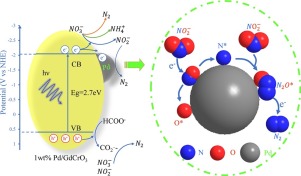Applied Catalysis B: Environment and Energy ( IF 20.2 ) Pub Date : 2018-03-19 , DOI: 10.1016/j.apcatb.2018.03.055 Zhiang Hou , Fangfei Chen , Jinnan Wang , Corvini Philippe François-Xavier , Thomas Wintgens

|
Although photocatalytic reduction of nitrate attracted much attention recently, undesired intermediate products (nitrite and ammonium) limited its application in practice. In this study, novel Pd/GdCrO3 composite was successfully synthesized to photo-catalytically reduce nitrate to N2 with high selectivity. Compared with TiO2 (P25), GdCrO3, Ag/GdCrO3 and Cu/GdCrO3, 1 wt% Pd/GdCrO3 achieved higher removal rate of nitrate (98.7%) and selectivity to N2 (100%). The kinetics constant of 1 wt% Pd/GdCrO3 was two times higher than that of P25. Even after six cycling runs, 1 wt% Pd/GdCrO3 still remained high photocatalytic reduction rate of nitrate (95.5%) and selectivity to N2 (98.4%). Such advantages were not only attributed to the negative conduction band value of GdCrO3 but also attributed to the co-catalyst effect of Pd. On one hand, nano particles Pd improved the utilization of charge carriers of GdCrO3. On the other hand, nitrite was easily reduced to NO* on nano particles Pd surface, followed by decomposition step to N* and O*, and then the reduction of nitrite in the vicinity of the N* could yield N2O* which would be preferentially transformed into N2. Accordingly, high concentration of nitrite accumulated initially could enhance the likelihood of N* encountering nitrite so as to increasing the N2 selectivity. In addition, electron paramagnetic resonance and hole scavenger experiments demonstrated that both photo-generated electrons and CO2− played important role in photocatalytic reduction process, suggesting a different mechanism from P25 where nitrate was mainly reduced by CO2
−. Thus, the present work not only prepared a promising photocatalyst for reduction of nitrate in water/wastewater treatment process, but also provided a simple and efficient way to improve the photocatalytic activity and selectivity to N2of photocatalysts.
中文翻译:

新型Pd / GdCrO 3复合材料,具有高选择性和高活性,可将硝酸盐光催化还原为N 2
尽管近来光催化还原硝酸盐备受关注,但不良的中间产物(亚硝酸盐和铵盐)限制了其在实践中的应用。在这项研究中,成功地合成了新型的Pd / GdCrO 3复合材料,以高选择性将光硝酸盐还原为N 2。与TiO 2(P25),GdCrO 3,Ag / GdCrO 3和Cu / GdCrO 3相比,1 wt%Pd / GdCrO 3获得更高的硝酸盐去除率(98.7%)和对N 2的选择性(100%)。1wt%的Pd / GdCrO 3的动力学常数是P25的动力学常数的两倍。即使经过六次循环运行,Pd / GdCrO 3的含量仍为1 wt%仍然保持较高的硝酸盐光催化还原率(95.5%)和对N 2的选择性(98.4%)。这样的优点不仅归因于GdCrO 3的负导带值,而且归因于Pd的助催化剂作用。一方面,纳米颗粒Pd提高了GdCrO 3的电荷载流子的利用率。另一方面,亚硝酸盐在纳米粒子Pd表面容易还原为NO *,然后分解为N *和O *,然后在N *附近还原亚硝酸盐可生成N 2 O *,优先转化为N 2。因此,最初累积的高浓度的亚硝酸盐可增加N *遇到亚硝酸盐的可能性,从而增加N 2的选择性。此外,电子顺磁共振和空穴清除剂实验表明,光生电子和CO 2-均在光催化还原过程中起着重要作用,暗示了与P25不同的机理,在P25中硝酸盐主要被CO 2-还原
。因此,本发明不仅制备了用于水/废水处理过程中还原硝酸盐的有前途的光催化剂,而且提供了一种简单有效的方法来提高光催化剂的光催化活性和对N 2的选择性。









































 京公网安备 11010802027423号
京公网安备 11010802027423号